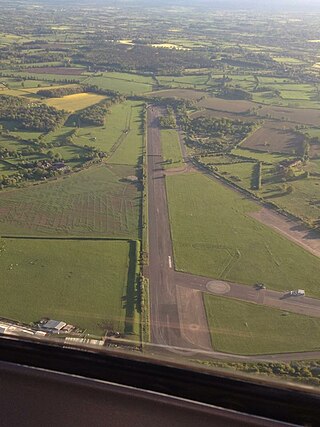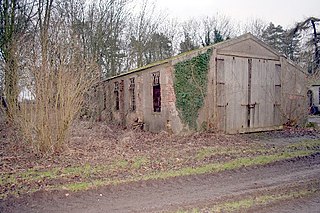
The Desert Air Force (DAF), also known chronologically as Air Headquarters Western Desert, Air Headquarters Libya, the Western Desert Air Force, and the First Tactical Air Force (1TAF), was an Allied tactical air force created from No. 204 Group RAF under RAF Middle East Command in North Africa in 1941 to provide close air support to the British Eighth Army against Axis forces. Throughout the Second World War, the DAF was made up of squadrons from the Royal Air Force (RAF), the South African Air Force (SAAF), the Royal Australian Air Force (RAAF), the United States Army Air Forces (USAAF) and other Allied air forces.

Royal Air Force Coltishall, more commonly known as RAF Coltishall, is a former Royal Air Force station located 10 miles north-north-east of Norwich, in the English county of Norfolk, East Anglia, which operated from 1939 to 2006.

Royal Air Force Tangmere or more simply RAF Tangmere is a former Royal Air Force station located in Tangmere, England, famous for its role in the Battle of Britain.

Royal Air Force Chivenor, or more simply RAF Chivenor, was a Royal Air Force station located on the northern shore of the River Taw estuary, on the north coast of Devon, England. The nearest towns are Barnstaple and Braunton.

Royal Air Force Scorton or more simply RAF Scorton is a former Royal Air Force satellite station located next to the village of Scorton in North Yorkshire, England. The base was opened in October 1939 as part of 13 Group RAF Fighter Command and a satellite station of RAF Catterick. It was used by the Royal Air Force, the Royal Canadian Air Force, and the United States Army Air Forces Ninth Air Force during the war.

Army Aviation Centre (AAC) Middle Wallop is a British Army airfield located near the Hampshire village of Middle Wallop, used for Army Air Corps training. The base hosts 2 (Training) Regiment AAC and 7 (Training) Regiment AAC under the umbrella of the Army Aviation Centre. 2 (Training) Regiment performs ground training; 7 (Training) Regiment trains aircrew on AAC aircraft after they complete basic training at RAF Shawbury.

Royal Air Force Fairwood Common, or more simply RAF Fairwood Common, is a former Royal Air Force Sector Station located on Fairwood Common, on the Gower Peninsula, to the west of Swansea. It is now the location of Swansea Airport.

Royal Air Force Honiley or RAF Honiley is a former Royal Air Force station located in Wroxall, Warwickshire, 7 miles (11 km) southwest of Coventry, England.

Royal Air Force Acklington, simply known as RAF Acklington, is a former Royal Flying Corps and Royal Air Force station located 3.2 miles (5.1 km) south west of Amble, Northumberland and 8.8 miles (14.2 km) north east of Morpeth, Northumberland.

Royal Air Force High Ercall or more simply RAF High Ercall is a former Royal Air Force sector station situated near the village of High Ercall, 7 miles (11 km) northeast of Shrewsbury, Shropshire, England.
Royal Air Force Grangemouth or more simply RAF Grangemouth is a former Royal Air Force station located 3 mi (4.8 km) north east of Falkirk, Stirlingshire, Scotland.

No. 219 Squadron of the Royal Air Force was founded in 1918 and disbanded in 1957 after four separate periods of service. During the First World War it served as a coastal defence unit, and through most of the Second World War and the 1950s it operated as a night fighter air defence squadron. Three commanders of the squadron went on to be Chiefs of the Air Staff, two of the RAF and one of the Royal Pakistani Air Force.

Royal Air Force Chedworth or more simply RAF Chedworth is a former Royal Air Force satellite station located near Chedworth, Gloucestershire, England. It was used mostly for training during its existence and has been inactive since the 1980s.

No. 81 Group was a group within the Royal Air Force's Fighter Command during the Second World War and the post-war era, which disbanded at the end of March 1958. It was initially formed during December 1940, lasting almost two and a half years before disbanding in April 1943. It reformed at the start of 1952.
Royal Air Force Tealing or more simply RAF Tealing is a former Royal Air Force station located at Tealing, Angus, Scotland.

No. 255 Squadron RAF was a Royal Air Force Squadron formed as an anti-submarine unit in First World War and a night-fighter unit in the Second World War. The First World War squadron was formed from former Royal Naval Air Service coastal flights and was responsible for coastal anti-submarine patrols. It was disbanded after the war.

Royal Air Force Wellingore or more simply RAF Wellingore is a former Royal Air Force fighter relief landing ground located 1.9 miles (3.1 km) south of Navenby, Lincolnshire and 10 miles (16 km) south of Lincoln, Lincolnshire, England.

776 Naval Air Squadron was a Naval Air Squadron of the Royal Navy's Fleet Air Arm which last disbanded at the end of October 1945. 776 Naval Air Squadron formed as a Fleet Requirements Unit at HMS Daedalus, RNAS Lee-on-Solent, at the start of 1941. It operated a detachment at RN Air Section Speke in 1941 and one at RAF Woodvale in 1942, with the squadron wholly moving to Speke in the October. 1943 saw further detachments and these were deployed at RAF Llanbedr, RAF Millom, RAF Usworth and RAF Waltham. In April 1945, the Woodvale detachment was reabsorbed into the squadron when it relocated there, the airbase now operated by the Admiralty and known as HMS Ringtail II. It moved to HMS Ringtail, RNAS, Burscough, at the start of October 1945.

No. 55 Operational Training Unit RAF(55 OTU) was an Operational Training Unit of the Royal Air Force, formed in November 1940 at RAF Aston Down to train fighter pilots.

















